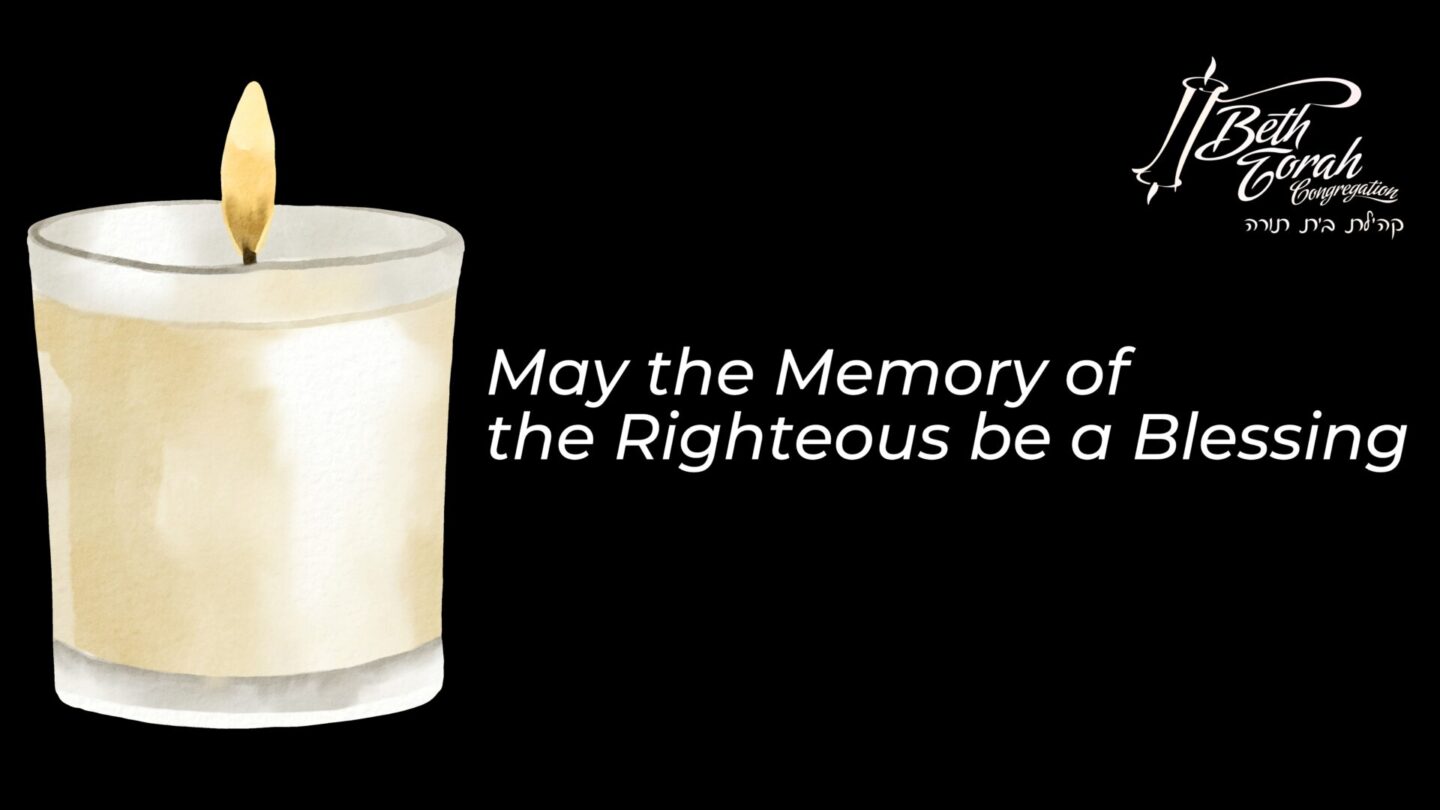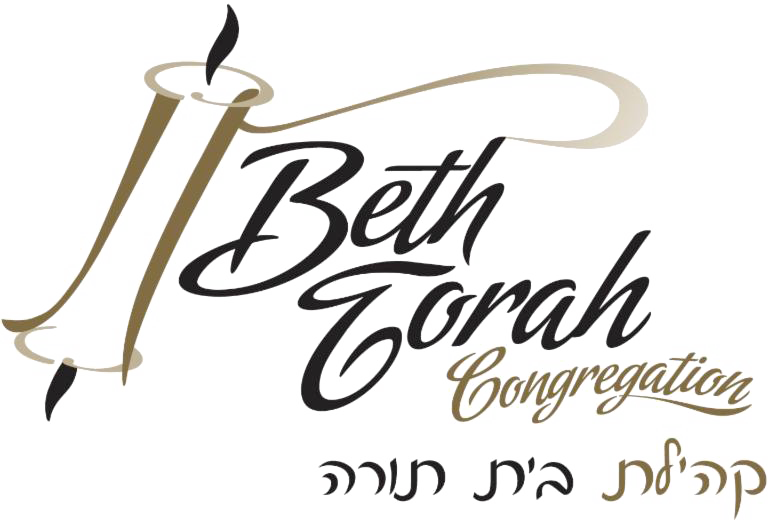
There are three ascending levels of mourning: with tears — that is the lowest. With silence — that is higher. And with a song — that is the highest.
– Abraham Joshua Heschel
Navigation
- Mourning at Beth Torah
- We respect your privacy.
- What is the Traditional Jewish Mourning Process?
- What are traditional Jewish funeral practices?
- What is Yizkor?
- When is Yizkor recited?
- What prayers do we say?
- When do I light the candle?
- Can I recite Yizkor at home?
- Why do we give Tzadakah?
Mourning at Beth Torah
We truly care about our members. At Beth Torah, our clergy is here for you during all lifecycle events, both simchas and unfortunate times of struggle, sadness, and distress.
To book a time to speak with our clergy at any stage of bereavement—whether you are struggling with impending loss or the aftermath, please contact us confidentially at director@bethtorah.ca or (416) 782 4495 ext. 2.
If you need to reach clergy after hours regarding an end-of-life circumstance, please call (416) 782-4495 during business hours, and 647-905-7165 after hours, weekends and holidays.
You may also connect with a funeral home such as Benjamin’s Park Memorial Chapel or Steeles Memorial Chapel to begin the funeral process.
We respect your privacy.
With your consent only, we will send out a bereavement e-notice upon the passing of a loved one, and mention funeral details in our printed bulletin, to allow congregants to offer their sympathies and attend services for the deceased.
To learn about Beth Torah’s cemetery policy, please admin@ or call (416) 782-4495 ext. 27.
Beth Torah’s clergy is here to offer support and solace, attend shivas, as well as send out condolences and end-of-shloshim letters. We also record yahrzeits and acknowledge them with a letter to member families every year.
Beth Torah’s Chesed Committee is also available should you need assistance.
What is the Traditional Jewish Mourning Process?
The traditional Jewish mourning process, known as “shiva,” has several components which occur throughout various moments in time, from the moment of the passing of the loved one to the anniversary of the loss each year, beautifully echoing the natural human response to the loss of a loved one, reflecting the gradual healing after death while acknowledging that the mourner’s world, and the world entire, is forever changed.
Mourning looks different for each and every family and individual. We have outlined the traditional process below, but we encourage you to speak with our clergy in order to engage with these traditional practices in a way which is meaningful to you.
- Aninut: This is the initial stage that begins immediately after the death of a loved one and continues until the burial. During this time, close family members are exempt from most religious obligations and focus on making funeral arrangements and mourning their loss.
- Shiva: Following the burial, the formal mourning period called “shiva” begins. Shiva typically lasts for seven days and is observed by the immediate family. During this time, mourners stay at home and receive condolences from visitors who come to offer support. The mourners traditionally sit on low stools or on the ground, symbolizing their grief. It is customary for mirrors to be covered, and for mourners to refrain from engaging in personal grooming or wearing leather shoes.
- Shiva house: The home of the mourners becomes the central location for shiva, where family, friends, and community members come to pay their respects. Prayers, called minyan, are recited daily, and mourners often share stories and memories of the deceased.
- Kaddish: The mourner recites the Kaddish prayer, a special prayer of praise to God, during the shiva period and beyond. The Kaddish is recited for 11 months for a parent and 30 days for other close relatives.
- Sheloshim: Following the conclusion of shiva, there is an extended mourning period called “sheloshim,” which lasts for 30 days. During this time, mourners gradually return to their daily routines but may continue to abstain from certain activities or celebrations.
- Yahrzeit. Each year, on the anniversary of the loved one’s passing, a memorial candle is lit, and the mourner may observe a special day of remembrance called “yahrtzeit.” Family members often visit the gravesite and recite prayers in memory of the deceased.
What are Traditional Jewish funeral practices?
Just as the traditional period of mourning varies for each community and individual, the same is true of Jewish funerals. Once again, we have outlined the traditional practices below, but we encourage you to speak to our clergy with any questions.
- Taharah: Before the funeral, the body is prepared for burial in a ritual called “taharah.” It involves ritual washing and purification performed by a group of individuals called the “Chevra Kadisha”. The body is treated with utmost respect and modesty.
- Shemira: After taharah, the body is watched over by designated individuals known as “shomrim” or “guards” until the burial takes place. This practice ensures that the deceased is never left alone until their final rest.
- Hespedim: At the funeral service, family members and close friends may deliver eulogies, known as “hespedim,” to honor and remember the deceased. Hespedim often include stories, reflections, and teachings about the life and character of the individual.
- K’riah: A symbolic tearing of clothing, known as “k’riah,” is performed by immediate family members. This act expresses the deep grief and loss experienced by the mourners. Typically, a black ribbon is provided to those mourning the loss of a parent, spouse, child, or sibling, which they wear for a period of time.
- Procession and Burial: The funeral procession accompanies the deceased to the burial site, where Jewish law emphasizes the principle of simplicity and equality in burial. The casket is typically made of plain wood and left unadorned. Jewish tradition discourages embalming and encourages a swift burial whenever possible.
- Kaddish: Following the burial, the immediate mourners participate in the recitation of the Kaddish prayer. The Kaddish is recited by close relatives during the mourning period and at specified times during the year to honor the memory of the deceased.
What is Yizkor?
In the Yizkor service, we come together as a community to remember those we’ve loved and have shaped us into who we are today. The essence of Yizkor comes from its Hebrew root- zachor, “to remember.” We ask God to remember our loved ones who are no longer with us, and “to bind them in the bonds of life.”
Yizkor is unique because we come together publicly to recite these prayers. Most Jewish mourning rituals are more private. They take place at the funeral chapel, graveside, or in our homes. Instead, this ritual takes place in the synagogue with all the members of our community who have experienced loss. Yizkor is a private moment in a very public setting.
There is a powerful reminder in the duality of this act- the nature of this ritual calls out to remind us that we are not alone.
We each may mourn different people. Each of us has our personal experience of loss that is uniquely our own. Yet by standing together in this moment, we are reminded that others also feel the pain of loss. We are made aware that others also experience the emptiness we face. In our private grief we are pushed to remember the universal roots of our own emotions. Loss is an experience that binds humanity together.
Initially, Yizkor was only recited on Yom Kippur and connected with a custom to give tzedakah in memory of the deceased. The common understanding was that by performing a mitzvah in honour of someone who has died would help their soul rise up to Olam Haba, “the world to come.”
A more modern understanding is that by performing mitzvot in honour of someone we have lost, we make a powerful statement about the legacy they have left behind. Even though their physical presence may not remain in this world, they continue to impact the world in a very real way. Our deeds become their deeds, and our actions become their actions.
Even though they are no longer with us, they continue to shape the world we live in. Perhaps even decades after they’ve passed, through us, they can continue to make the world a better place.
As you recite these prayers, remember the person you recite them for not simply in the past tense, but ensure that their memory will impact who you are and how you live. In doing so we can ensure that those we remember will continue to live in our world each and every day.
When is Yizkor Recited?
Yizkor is recited four times a year during the major holidays.
In the Hebrew year 5783-5784, or 2023-2024 in the secular calendar the dates of Yikzor are:
- Yom Kippur
- Shemini Atzeret
- Passover
- Shavuot
What Prayers do we say?
Different communities have different customs of what to include in the Yizkor service. Various psalms, readings, or songs are used to set the mood. The main section is the actual prayer of remembrance shown in the next section. Often El Malei, the memorial prayer recited at a funeral is included. Some communities add addition memorial prayers for those who were murdered in the Shoah, victims of terrorism, or for members of the synagogue. Lastly, many communities will also recite the mourners kaddish as part of the Yizkor service.
When do I light the candle?
Traditionally one lights a memorial candle in honor of their loved one. One can find in a Judaica shop, synagogue, or online special candles that will burn for the whole day.
The candle is lit the night before because that is when the holiday begins in the Jewish calendar.
Traditionally the memorial candle should be allowed to burn for the entire holiday. However it is important that the candle be place somewhere safe, and not be left unattended. One should always err on the side of caution and blow out the candle if you are worried about potential danger. (There are also electric candles one can purchase and use instead, if they are unable to light a traditional candle safely.)
Can I recite Yizkor at home?
While there is something special about being together as a community and recognizing that loss is a universal experience, one can recite the prayers of yizkor at home. The mourners kaddish is the only prayer that requires one to be with ten Jewish adults, and traditionally it was not recited as part of the yizkor service.
Why do we give Tzedakah?
As part of the text of Yizkor we pledge to donate tzedakah in memory of someone to fulfill a mitzvah in their honor. One can also take on other mitzvot, or commandments, to honor their loved one’s memory.
Some potential mitzvot are:
- Volunteer at a soup kitchen
- Collect supplies for the those in need
- Visit people in the hospital or nursing home
- Study a Jewish text, or join a class at a synagogue
